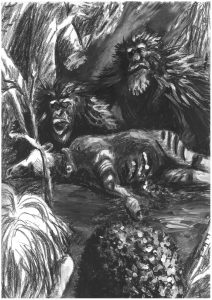In 1989, deep inside the Ituri Forest, Dr John Hart and radio tracker Nobirabo encountered 2 adult male chimpanzees crouched over the carcass of a radio-collared okapi which had just been killed by a leopard. What happened next is described in a chapter of the new book “Chimpanzee Behaviour: Recent Understandings from Captivity and the Forest”.
In this chapter Dr. Hicks also describes other examples of meat-eating in this hitherto little-known population of chimpanzees. One of these is an account of a chimpanzee eating a leopard carcass. “Both behaviors are relevant to human evolution, as at some point our own ancestors are thought to have begun hunting larger animals, as well as pirating the kilss of big carnivores,” says Dr. Hicks.
Hicks and his coauthors present direct and indirect evidence of predation on vertebrates by Eastern chimpanzees (Pan troglodytes schweinfurthii) at two sites in the northern Democratic Republic of the Congo: Bili-Uéré and Ituri, which are part of one of the largest and most interconnected chimpanzee populations in Africa. In this chapter, scientists provide the first data on chimpanzee prey preferences in the region, which at Bili-Uéré includes direct evidence for consumption of a leopard (Panthera pardus) and indirect evidence for consumption of a tree pangolin (Phataginus tricuspis) and two tortoise species of the genus Kinixys. In the Ituri Forest, they describe a direct observation of chimpanzees guarding and probably consuming the carcass of an okapi (Okapia johnstoni), likely pirated from a leopard, as well as indirect evidence of tortoise consumption. Further east in an Ituri forest fragment, the scientists recorded an adult female chimpanzee carrying the carcass of a galago, probably Galagoides thomasi, although they did not confirm consumption. Altogether, these observations give us a portrait of a chimpanzee population with an unusual selection of vertebrate prey.
Dr. Hicks plans to visit the Epulu area with the student, which is where the okapi event described above took place.
More information you can find in the chapter entitled “Handling and Consumption of Vertebrate Prey by Chimpanzees (Pan troglodytes schweinfurthii) in the Northern Democratic Republic of the Congo”. This chapter is found in the new book entitled “Chimpanzee Behaviour: Recent Understandings from Captivity and the Forest” (editor: Mary Lee Abshire Jensvold, PhD).



